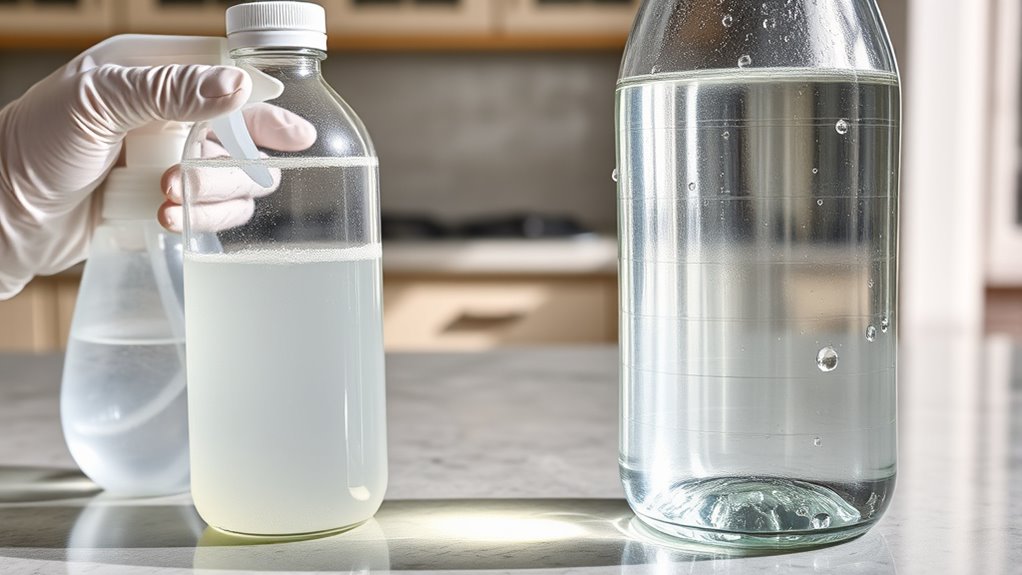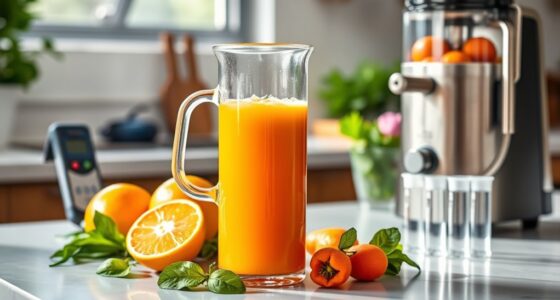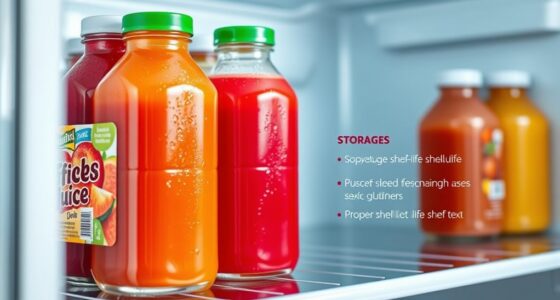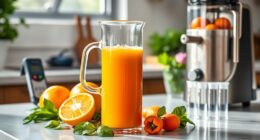When sanitizing juice bottles at home, bleach kills bacteria and viruses quickly but requires thorough rinsing and careful handling to avoid health risks. Vinegar offers a natural, eco-friendly option that’s safe for regular use but may not fully eliminate all pathogens. Both work if used properly, yet vinegar is gentler on the environment. Want to learn more about choosing the best method for safe, effective cleaning? Keep exploring for detailed tips.
Key Takeaways
- Bleach quickly and effectively disinfects juice bottles but requires thorough rinsing to prevent health risks.
- Vinegar is a natural, eco-friendly option suitable for routine cleaning but may need more frequent application for sanitation.
- Bleach offers superior pathogen elimination but has environmental and safety concerns; vinegar’s impact is minimal.
- Proper handling and rinsing are essential regardless of whether using bleach or vinegar to ensure safety.
- For deep sanitation, bleach is more reliable, while vinegar is preferable for regular, eco-conscious cleaning.

Are bleach and vinegar effective options for sanitizing juice bottles? When it comes to ensuring food safety at home, choosing the right cleaning method is vital. Both bleach and vinegar are popular for cleaning and sanitizing, but they differ markedly in their effectiveness and environmental impact. Food safety is your top priority, so understanding how each option works helps you make an informed decision.
Bleach, specifically sodium hypochlorite, is known for its powerful disinfectant qualities. It can kill a wide range of bacteria, viruses, and mold, making it a reliable choice for sanitizing juice bottles. When used correctly—diluted properly—it can eliminate germs that might cause foodborne illnesses. However, you must rinse thoroughly after sanitizing, as residual bleach can pose health risks if ingested. Bleach sanitizing solutions are quick and effective, but they come with environmental concerns. Once washed down the drain, bleach can contribute to water pollution, harming aquatic life and disrupting ecosystems. Its chemical properties mean it doesn’t break down easily in the environment, raising sustainability questions.
Bleach effectively disinfects but poses environmental and health risks if not rinsed thoroughly.
Vinegar, on the other hand, is a natural and eco-friendly option. Its acetic acid content provides antimicrobial properties that can reduce bacteria and other microbes on surfaces, including juice bottles. While vinegar may not be as potent as bleach against all pathogens, it’s a safe choice for regular cleaning, especially if you’re concerned about chemical residues. Vinegar also scores high on environmental impact because it’s biodegradable and doesn’t release harmful chemicals into water systems. Additionally, using vinegar aligns with eco-conscious practices, reducing your household’s overall environmental footprint. That said, vinegar alone might not eliminate all germs, so it’s often recommended for routine cleaning rather than deep disinfection.
Furthermore, recent advancements in AI-driven cleaning technology suggest that using smart cleaning tools can enhance sanitation practices, ensuring more thorough and consistent results. When weighing your options, consider both food safety and environmental impact. Bleach offers superior disinfecting power but at a potential environmental cost and with the need for careful handling and rinsing. Vinegar provides a safer, greener alternative, which is gentle on both your health and the planet, but it might require more frequent applications to maintain a high level of cleanliness. Ultimately, your choice depends on your specific needs—whether you prioritize maximum disinfection or environmental sustainability. For everyday use, vinegar can be sufficient, especially with thorough cleaning practices. For situations demanding more rigorous sanitation, bleach might be necessary, but always use it responsibly. Remember, whichever method you choose, proper rinsing and handling are essential to keep your juice bottles safe and your household healthy.
Frequently Asked Questions
Can Vinegar Completely Replace Bleach for Sterilizing Juice Bottles?
Vinegar can’t completely replace bleach for sterilizing juice bottles, especially if you’re aiming for thorough sanitation. While vinegar alternatives like hydrogen peroxide may help, vinegar’s effectiveness is limited and can be influenced by bottle material effects. Some plastics may degrade or retain odors, reducing cleanliness. For best safety, consider using a proper sanitizing solution or bleach when sterilizing bottles, ensuring you’re effectively eliminating germs without damaging your containers.
Are There Any Health Risks Associated With Using Bleach or Vinegar on Bottles?
Think of your bottles as sacred vessels; using bleach or vinegar carries risks if not handled properly. Bleach poses chemical safety concerns, leaving harmful residue if not rinsed thoroughly, which could affect health. Vinegar is safer but may still leave residues that impact taste. Always guarantee proper rinsing regardless of the disinfectant, and follow safety guidelines to avoid chemical safety issues and residue concerns that could compromise your health.
How Long Should Bottles Sit in the Sanitizing Solution?
You should let your bottles sit in the sanitizing solution for the recommended contact duration, which is typically about 2 minutes. Following the timing guidelines guarantees effective sanitation without risking damage or residue. Make sure to thoroughly rinse bottles with clean water afterward to remove any remaining solution. Proper contact duration is key to eliminating germs and bacteria, keeping your bottles safe for reuse.
Is There a Difference in Effectiveness Between Homemade and Commercial Sanitizers?
Yes, there’s a difference in effectiveness between homemade sanitizers and commercial disinfectants. Commercial disinfectants are specifically formulated and tested for maximum pathogen elimination, making them more reliable for sanitizing your juice bottles. Homemade sanitizers, like vinegar or diluted bleach, can work but may not be as consistent or potent. For safest results, use commercial disinfectants or follow proper homemade sanitizer recipes with correct dilution and contact time.
Can Repeated Use of Vinegar Damage Plastic Juice Bottles Over Time?
Repeated use of vinegar can cause plastic degradation and vinegar corrosion over time, which may weaken your juice bottles. Vinegar’s acidity slowly breaks down certain plastics, leading to potential cracks or leaks. To avoid damage, consider using bottles specifically designed for acidic liquids or limit the number of times you sanitize with vinegar. Regularly check your bottles for signs of wear to ensure they stay safe and functional.
Conclusion
So, next time you’re cleaning juice bottles, remember that whether you choose bleach or vinegar, both can do the trick—just like how you might find that perfect bottle cap hiding in the back of your cupboard when you least expect it. Sometimes, the best solutions come from simple choices, and in this case, your clean, sanitized bottles are just a rinse away. Coincidentally, a little attention now keeps your drinks safe and your kitchen running smoothly.
Cindy thoroughly researches juicing trends, techniques, and recipes to provide readers with practical advice and inspiration. Her writing style is accessible, engaging, and designed to make complex concepts easy to understand. Cindy’s dedication to promoting the advantages of juicing shines through her work, empowering readers to make positive changes in their lives through the simple act of juicing.
















